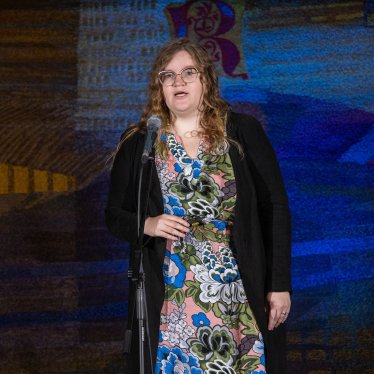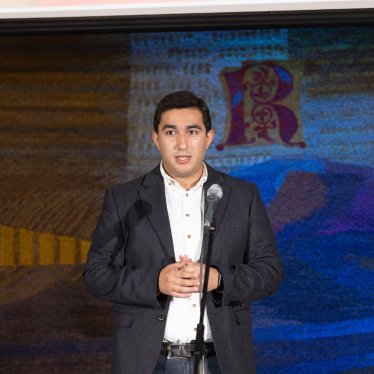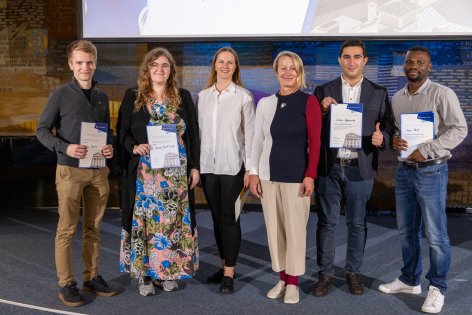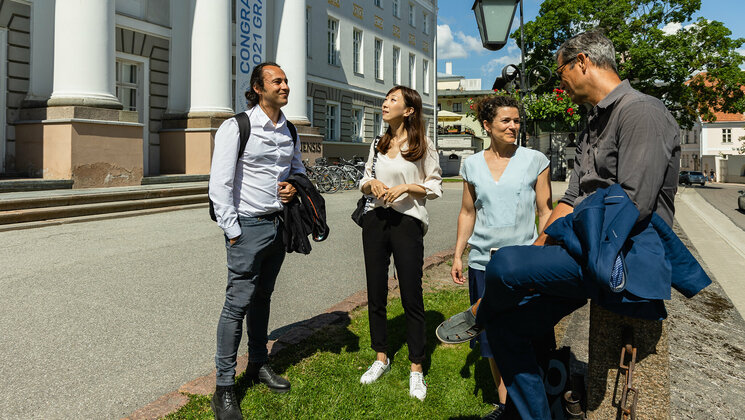Best three-minute lectures dealt with mathematics, economy and wetlands
The three-minute thesis competition for University of Tartu doctoral students brought together young researchers of many disciplines. At this year's competition on 28 September, 24 doctoral students held 25 presentations, including eight in Estonian and 17 in English. The three best Estonian presenters will represent the University of Tartu at the Estonian Academy of Sciences' "Science in Three Minutes" competition. The best English presentation will represent the University of Tartu at the international Coimbra Group 3-Minute-Thesis competition.
Top three in the Estonian competition
- Hanna Britt Soots "Mathematics helps us understand the world better"
- Martin Haamer "Does taking the bus have to be slow?"
- Laura Mauring "Genetic eye diseases: the enemy in the darkness"
Image

Hanna Britt Soots, Junior Research Fellow in Mathematics at the Institute of Mathematics and Statistics, skilfully introduced the concept of diffusion and explained the applications of this phenomenon in many other fields of science and life, such as physics, chemistry and biology.
Martin Haamer, Junior Research Fellow in Transport Studies at the Institute of Ecology and Earth Sciences, explained how using mobile positioning data can improve bus services and increase people's willingness to use public transport.
Laura Mauring, Junior Research Fellow in Ophthalmology at the Institute of Clinical Medicine, spoke about the genetic background of hereditary eye diseases and gave hope that in the future, the diagnosis and treatment of these diseases could improve thanks to the work of researchers.
Top three in the English competition
- Elchin Aghazada "The Dating Game: Companies, Institutions, and the flirt with Innovation"
- Isaac Okiti "Wetland Restoration and Management Strategies"
- Baiba Brumele "TRMT112 – the mysterious link between different diseases"
Image

Elchin Aghazada, Junior Research Fellow in Economics at the School of Economics and Business Administration, explained how companies' innovation performance is influenced by the strength of national institutions and the country's broader cultural context.
Isaac Okiti, Junior Research Fellow in Ecotechnology at the Institute of Ecology and Earth Sciences, spoke about solving the bottlenecks in wetland restoration. For instance, he explained how to restore wetlands so that as much carbon is sequestered as possible, while keeping methane emissions low.
Baiba Brumele, Junior Research Fellow in Technology at the Institute of Technology, introduced the nature and the mechanisms of TRMT112, a protein found in all of us. It is a molecule that mammals cannot live without, yet it is associated with cancer, autism and Down's syndrome.
This year, the audience could also choose their favourite presentation. The audience favourite award went to Junior Research Fellow in Ecotechnology Isaac Okiti.

A diverse selection of short popular-science lectures
Participants were from all faculties of the university: 14 from the Faculty of Science and Technology, five from the Faculty of Social Sciences, three from the Faculty of Medicine, and two from the Faculty of Arts and Humanities. The doctoral students had to make an engaging three-minute presentation in Estonian or English that gave a brief overview of the problem that prompted their research, the ways to solve it, the initial results, and the impact.
The jury commended the thorough preparation of the doctoral students and the quality of the lectures. "The ability to talk about their research in a way that allows a non-expert listener to understand and relate to the topic is very important for a researcher. This is a good prerequisite for both cross-disciplinary research and the dissemination of research results to society," said Piret Ehrenpreis, a member of the jury and Research Communication Adviser at the University of Tartu.
The jury also included Airika Harrik, journalist at the ERR research news portal Novaator, Kertu Liis Krigul, finalist of last year's competition of the Estonian Academy of Sciences and Junior Research Fellow in Microbiomics at the University of Tartu, Mariliis Kolk, research journalist and translator at Postimees, Imar Koutchoukali, Junior Research Fellow at the School of Theology and Religious Studies, and Monika Tasa, Development Adviser at the Office of Academic Affairs.
Competition helps doctoral students' research reach a wider audience
The top three of the Estonian competition will represent the university at the Estonian Academy of Sciences' "Science in 3 Minutes" competition at the beginning of next year. In the coming months, doctoral students get the chance to participate in training sessions at the Estonian Academy of Sciences, honing their skills in writing popular science articles and making on-camera presentations. The doctoral students' articles will be published on the research news portal Novaator, and in February, the five finalists of the national competition will be announced in the hall of the Estonian Academy of Sciences.
The video recording of the best English presentation will be sent to the competition of the international university network Coimbra Group. There, an international jury will select the three best among all participants, who will have the opportunity to present their work in the final 3MT competition taking place at the network's annual conference.
The three-minute thesis competition is a great opportunity for young researchers to get more public resonance for their research, develop their presentation and communication skills and hear about the work of other doctoral students. A video recording was made of each presentation. Some lectures will also be published on ERR Novaator.
The competition is organised by the University of Tartu's Office of Academic Affairs, Marketing and Communication Office and International Cooperation and Protocol Office.



